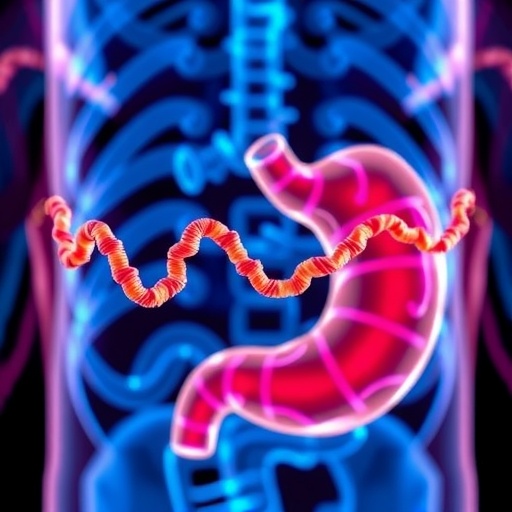In the ongoing battle against gastric cancer, a formidable foe with complex biological underpinnings, the protein annexin A1 (ANXA1) has emerged as a beacon of potential—a molecular player whose roles may redefine therapeutic strategies and diagnostic paradigms. Recent groundbreaking research, led by Xiong and colleagues, has illuminated the multifaceted involvement of ANXA1 in gastric cancer cells, offering a detailed exploration that could catalyze a shift in oncological approaches. This new comprehensive study delves deeply into the mechanistic pathways modulated by ANXA1, unveiling its dualistic nature in tumor biology and hinting at promising clinical applications.
The biological significance of ANXA1 transcends simplistic categorization. As a member of the annexin family, it is renowned for its ability to bind phospholipids in a calcium-dependent manner, influencing diverse cellular processes including membrane trafficking, inflammation, and apoptosis. Within the cytological theater of gastric cancer, ANXA1 exhibits a complex role that varies depending on cellular context and tumor microenvironment. The nuanced behavior of ANXA1 underscores the challenge of harnessing its function—it can act as a tumor suppressor in some gastric cancer phenotypes while promoting oncogenic pathways in others. This Janus-faced protein thus demands a sophisticated understanding to unlock its clinical potential.
At the molecular level, the study elucidates how ANXA1 expression is intricately linked with key signaling cascades that govern cell proliferation, migration, and invasion—hallmarks of cancer aggressiveness. The researchers demonstrated that altered expression of ANXA1 affects the epithelial-to-mesenchymal transition (EMT), a critical process in tumor metastasis. Specifically, aberrant ANXA1 levels modulate EMT markers, impacting cell adhesion molecules and cytoskeletal dynamics, which are essential for cancer cells to dissociate and colonize distant organs. This insight positions ANXA1 as a pivotal regulator of metastatic competence in gastric cancer.
Moreover, the involvement of ANXA1 in apoptotic regulation adds an intriguing layer to its oncological significance. ANXA1 modulates apoptotic pathways by interacting with key effector molecules, influencing cell survival outcomes in response to chemotherapeutic agents. The study highlights how increased ANXA1 levels enhance resistance to apoptosis, potentially leading to chemoresistance—a significant hurdle in effective gastric cancer treatment. Conversely, targeted manipulation of ANXA1 expression can sensitize tumor cells to apoptosis, revealing a strategic target for therapeutic intervention.
One of the pivotal revelations from this research is the potential application of ANXA1 as a biomarker for gastric cancer prognosis. Through robust clinical sample analyses, ANXA1 expression profiles were correlated with tumor stage, grade, and patient survival rates. Elevated ANXA1 expression consistently associated with advanced disease and poorer prognoses, underscoring its utility not merely as a molecular marker but as a prognostic tool which could guide personalized treatment modalities. This prognostic linkage could aid in stratifying patients based on risk and in tailoring precise therapeutic regimens.
The therapeutic prospects of targeting ANXA1 open new frontiers in oncology. The researchers explored strategies to modulate ANXA1 activity using molecular inhibitors and RNA interference techniques. These experimental approaches successfully altered cancer cell behavior, reducing proliferation and metastatic potential in vitro and in vivo models. Importantly, ANXA1-based interventions appear capable of overcoming resistance to conventional chemotherapy, suggesting a synergistic avenue that could enhance current treatment efficacy and mitigate toxic side effects.
Beyond its intrinsic biological functions, ANXA1 also orchestrates intricate cross-talk within the tumor microenvironment, influencing immune cell infiltration and inflammatory responses. The study highlights how ANXA1 modulates the secretion of cytokines and chemokines, thereby shaping an immunosuppressive milieu that facilitates tumor escape from immune surveillance. This immunomodulatory role of ANXA1 invites consideration for integration with immunotherapeutic strategies, potentially improving the responsiveness of gastric cancers to immune checkpoint inhibitors and other novel immune-based therapies.
Intriguingly, the dynamic expression of ANXA1 during cancer progression hints at its role in tumor heterogeneity—an acknowledged challenge in oncology. The spatial and temporal variations of ANXA1 among different tumor regions and stages suggest that therapeutic targeting will require adaptive strategies to address this heterogeneity. Future research aimed at delineating precise ANXA1 expression dynamics could pave the way for temporally optimized treatment protocols, enhancing the precision medicine landscape for gastric cancer.
The methodological robustness of this study stands out as well, combining cutting-edge genomic, transcriptomic, and proteomic analyses to achieve a multidimensional understanding of ANXA1 functions. By integrating data from human tissue samples, cancer cell lines, and animal models, the researchers constructed a comprehensive biological narrative. The use of CRISPR/Cas9 gene editing and high-resolution imaging techniques further substantiated their findings, representing a methodological gold standard in cancer research.
The implications of these findings extend beyond gastric cancer, as ANXA1 dysregulation is a recurrent theme in various tumor types. Understanding the commonalities and differences in ANXA1’s role across cancers may inspire novel pan-cancer therapeutic strategies or facilitate repurposing of ANXA1-targeted agents. Furthermore, the elucidation of ANXA1-interacting partners could reveal additional druggable targets, expanding the molecular arsenal against cancer.
As the scientific community digests these insights, patient advocacy and clinical translation remain pressing concerns. The road from bench to bedside will necessitate rigorous clinical trials to validate ANXA1-targeted therapies, establish safety profiles, and determine efficacy across diverse patient populations. Meanwhile, the potential of ANXA1 as a diagnostic and prognostic biomarker could accelerate implementation in clinical workflows, guiding oncologists in the era of precision oncology.
Ultimately, Xiong and colleagues’ study heralds a new chapter in the fight against gastric cancer by spotlighting ANXA1 as a multifaceted regulator with therapeutic and diagnostic promise. The integration of ANXA1 biology into clinical practice offers hope for improved patient outcomes amid this challenging malignancy. As research advances, the nuanced understanding of ANXA1’s role will empower oncologists with novel tools to combat gastric cancer’s complexity, heralding an era where molecular insights translate into life-saving interventions.
Subject of Research: The role and application prospects of annexin A1 (ANXA1) in gastric cancer cells.
Article Title: The role and application prospects of ANXA1 in gastric cancer cells.
Article References:
Xiong, Q., Wang, J., Liu, Y. et al. The role and application prospects of ANXA1 in gastric cancer cells. Med Oncol 43, 19 (2026). https://doi.org/10.1007/s12032-025-03137-x
Image Credits: AI Generated




